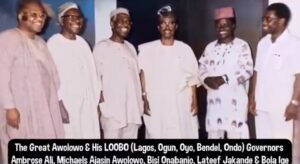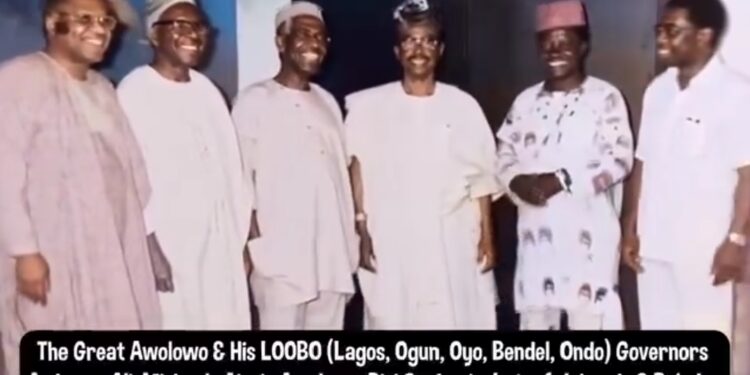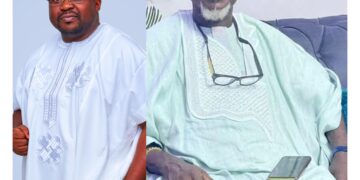The LOOBO Legacy: How Awolowo’s Dream Team Shaped the Path Nigeria Still Seeks

By Ibrahim Kegbegbe
I still remember the first time I stumbled upon that black-and-white photograph — Chief Obafemi Awolowo in his signature cap, flanked by five governors whose names now echo like a hymn of lost possibilities: Ambrose Alli, Michael Ajasin, Bisi Onabanjo, Lateef Jakande, and Bola Ige. It wasn’t in a museum or history textbook; it was tucked in the corner of an old newsroom archive, its edges frayed, its faces frozen in quiet confidence. As a journalist, I have seen countless political images, but this one stopped me cold. Here was a moment in time when leadership meant service, when politics was a vehicle for ideas, not self-enrichment. In today’s Nigeria — where public trust in governance hovers dangerously low — I knew I had to tell this story, not as a nostalgia piece, but as a mirror and a challenge.
A Photograph That Holds a Nation’s Memory
There are photographs that freeze mere moments, and there are photographs that freeze entire philosophies. One such image is of Chief Obafemi Awolowo — the “Sage” of Nigerian politics — surrounded by five governors: Ambrose Alli of Bendel, Michael Adekunle Ajasin of Ondo, Bisi Onabanjo of Ogun, Lateef Jakande of Lagos, and Bola Ige of Oyo. Collectively, they became known as LOOBO — an acronym drawn from their states.
It is more than a group portrait. It is a political statement. The photograph captures an era when governance was deliberate, principled, and people-centered; when the political class of the South-West (and Bendel) sought to redefine Nigerian leadership in the aftermath of military rule and political instability.
The Sage: Obafemi Awolowo’s Intellectual Blueprint
Obafemi Awolowo’s political life was a masterclass in vision-driven governance. As Premier of the Western Region from 1954 to 1960, his government introduced the first free primary education programme in Africa, established the Western Nigerian Television (the first in Africa), built the Cocoa House in Ibadan (then the tallest building in West Africa), and pioneered rural electrification.
Awolowo’s belief was clear:
“The children of the poor you fail to train will never let your children have peace.”
This wasn’t mere rhetoric. His philosophy of welfarism — an economic model that channels public resources into mass education, healthcare, and infrastructure — became the bedrock of the Unity Party of Nigeria (UPN), which he led in the Second Republic.
The Governors Who Carried the Torch
Lateef Kayode Jakande – Lagos State
Affectionately called “Baba Kekere” (little father) for his loyalty to Awolowo, Jakande governed Lagos from 1979 to 1983. He built more than 20,000 units of low-cost housing, established numerous public schools, and conceived the Lagos Metroline project — a rail transport plan that could have transformed Lagos decades ago had it not been abruptly cancelled by the military.
Jakande believed in pragmatic politics:
“I don’t talk about what I will do; I do it, and the people will see.”
Chief Bisi Onabanjo – Ogun State
A trained journalist and satirist (famed for his Aiyekooto column), Onabanjo brought intellectual clarity and fiscal prudence to Ogun. He expanded rural road networks, strengthened agriculture through cooperative societies, and promoted education. Olabisi Onabanjo University stands as his legacy.
His governance ethos was summed up when he said:
“A government that cannot be accountable to its people is not worth being in office.”
Chief Bola Ige – Oyo State
Ige, often called the “Cicero of Esa-Oke” for his oratory, transformed Oyo with rural electrification, water supply projects, and an aggressive educational expansion programme. He was known for personally visiting rural communities to assess projects.
He famously warned:
“If you leave politics to charlatans, don’t be surprised when they turn your country into a circus.”
Professor Ambrose Alli – Bendel State
A medical doctor turned politician, Alli declared free education in Bendel and built more than 600 secondary schools in four years. He understood that education was not just an investment in individuals but in the collective progress of a society.
He once said:
“If we build the minds of our children, they will build the roads and bridges of the future.”
READ ALSO:Killing Journalists is Killing the Truth — Israel Must Be Held to Account
Chief Michael Adekunle Ajasin – Ondo State
Ajasin, elder statesman and incorruptible administrator, led Ondo with integrity. He strengthened rural economies, prioritised teacher welfare, and invested in public infrastructure without leaving the state in debt.
Ajasin was blunt in his belief:
“A leader who uses his position for personal gain is the worst enemy of the people.”
A Common Governance Template
Under the UPN, these governors followed a shared manifesto:
1. Free education at all levels
2. Free health care for all
3. Integrated rural development
4. Full and gainful employment
5. Infrastructural development
Unlike today’s political promises, these were implemented. By 1983, literacy rates in their states were among the highest in Nigeria, rural communities had unprecedented access to electricity and roads, and public trust in government was tangible.
The Historical Context
The Second Republic (1979–1983) was a turbulent time. Nigeria was flush with oil money but plagued by mismanagement. Military rule had eroded democratic culture. Awolowo and his governors stood as the ideological opposition to the ruling National Party of Nigeria (NPN), often enduring political harassment.
Their ideological battles were fierce but policy-driven — debates over subsidies, education funding, and economic diversification. This was politics of ideas, not of ethnic slurs or social media propaganda.
Why the LOOBO Era Still Matters
Today, Nigeria is adrift. Corruption, insecurity, unemployment, and economic hardship dominate headlines. In such a climate, the LOOBO photograph is a reminder that leadership anchored on integrity, competence, and vision is possible.
These men were not flawless — no human leader is — but their record shows that governance can be both principled and effective. They governed in a way that made citizens feel that government belonged to them.
The Rallying Call
For Nigeria to recover, we must demand leaders who:
Possess a coherent vision, not vague slogans.
Value education and health as the foundations of national security.
Resist corruption not because it’s illegal, but because it’s immoral.
Govern for posterity, not the next election cycle.
It’s time for a new generation to study Awolowo and his LOOBO governors not as historical curiosities, but as governance models.
As Awolowo himself once urged:
“After rain comes sunshine; after darkness comes the glorious dawn. There is no sorrow without its alloy of joy; there is no joy without its admixture of sorrow. Behind the ugly, terrible mask of misfortune lies the beautiful, soothing countenance of prosperity.”
Beyond Nostalgia
The LOOBO legacy is not a museum piece. It is a living challenge to today’s political class: If they could do it with less technology, fewer resources, and more political hostility, why can’t you?
The photograph of Awolowo with Alli, Ajasin, Onabanjo, Jakande, and Ige is not just history — it is a mirror. It asks every Nigerian voter and leader alike: What kind of future will you choose?
If the answer leans toward justice, education, healthcare, and the common good, then perhaps — just perhaps — we can see the dawn Awolowo once promised.
Ibrahim Kegbegbe is a journalist and public affairs analyst. He writes from Lagos.
















